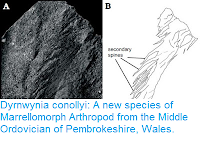The Arthropods are grouped together with two other living phyla, the Onychophorans (Velvet Worms) and Tardgrades to form a higher group called the Panarthropods, a group of limbed organisms thought to have evolved from a single Worm-like ancestor. The early origins of these groups are less than clear however; a variety of other Panarthropod groups, such as the Anomalocarids, which may have been early Arthropods, and the Lobopodians, which are thought to have been ancestral to the modern Onychophorans.
In a paper published in the journal BMC Evolutionary Biology on 31 January 2017, Jean-Bernard Caron of the Department of Natural History (Palaeobiology Section) at the Royal Ontario Museum, and the Department of Ecology and Evolutionary Biology and Department of Earth Sciences at the University of Toronto, and Cédric Aria, also of the Department of Ecology and Evolutionary Biology at the University of Toronto, describe a new species of Lobopodian from the Middle Camrian Burgess Shale Lagerstätte of Walcott Quarry in British Columbia.
The new species is named Ovatiovermis cribratus, where 'Ovatiovermis' means 'ovation-Worm' in reference to the presumed life posture of the species, standing on its hindlimbs with its forelimbs waving in the air, and 'cribratus' means 'to sieve'. The species is described from two specimens, one 30 mm in length and the other 12 mm. The species shows diffentiation of the limbs with short hind limbs and longer forelimbs covered in elongate claws, which Caron and Aria interpret as having been used for filter feeding (standing on hindimbs and sieving the water with upraised forelimbs).
Ovatiovermis cribratus from the Burgess Shale, Royal Ontario Museum (ROM) 52707: (a–e, i, j) part, (g, h) counterpart, (f) reconstructed death pose. Close-ups indicated by white rectangles. (a, b) full specimen under direct (a) and polarized (b) lighting conditions. (c–e) superposed elemental maps of carbon (red) and calcium (purple) before preparation of the 8th left lobopod (lL8—see a). The lighter colours represent higher concentrations of elements: parts of the gut, proboscis, pharyngeal area and claws are preserved in carbon whereas the rest of the body is preserved in calcium. (g–j) details of the anterior part of the body showing internal organs in Lobopods (g), pair of visual organs (g, h), spinules and bifid claws (g, i, j). Digital single-lens reflex (DSLR) images taken using direct light (a, i, j) and cross-polarized light (b, g, h), all under dry conditions except (b, g and h). A, annulations; C, claw; Ds, dark stain; E, “eye” (visual organ); G, gut; H, head; I, internal organ; L, lobopod (l, left; r, right; x,y, lobopod position); Lu; foregut lumen; M, mouth; Pr, proboscis; S, spinules. Scale bars: 5 mm (a–c, g, i), 1 mm (e, d, h, j). Caron & Aria (2017).
Previous reconstructions of the phylogeny of Cambrian Lobopodians has shown the presence of two distinct groups, the armoured Hallucigenians and the unamoured Luolishanids, which show greater limb diferentiation and are thought to have been ancstral to the modern Velvet Worms. A phylogenetic reconstruction made by Caron and Aria including Ovatiovermis cribratus placed the new species firmly within the Luolishanid group, but also suggested that both groups in fact split off from the other Panarthropods before the split between Tardigrades, Velvet Worms and Arthropods, suggesting the common ancestor of these groups was in fact Lobopodian-like.
The closet relatives of the Panarthropods are thought to be the Nematode, Priapulid and Palaeoscorid Worms, with the common ancestor of the Panarthropods thought to be something similar to Paucipodia, a Loboopd from the Early Cambrian Chengjiang Lagerstätte of China which resembles a Nematode with legs. However, while Caron and Aria's phylogeny did recover Paucipodia as close to the common ancestor of the living Arthopods, Velvet Worms and Tardigrades, it also suggests that the Luolishanids split from the other groups before the Hallucigenians, and that the Hallucigenians split off before Paucipodia, making the biology of the earliest Panarthropodian ancestor more uncertain than before.
See also...
Artistic interpretation of Ovatiovermis cribratus as a living animal. Danielle Dufault in Caron & Aria (2017).
Consensus tree of a Bayesian phylogenetic analysis of our morphological matrix composed of 38 taxa and 59 characters (four runs, 10,000,000 generations, burn-in fraction: 0.20). Total-group Onychophorans highlighted in green, Hallucigeniids in blue and Luolishaniids in red. Microdictyon and Facivermis are considered potentially included within Hallucigeniids and Luolishaniids, respectively, which is denoted by the coloured dashed lines. Numbers above branches represent posterior probabilities. Caron & Aria (2017).
See also...
Follow Sciency Thoughts on Facebook.









